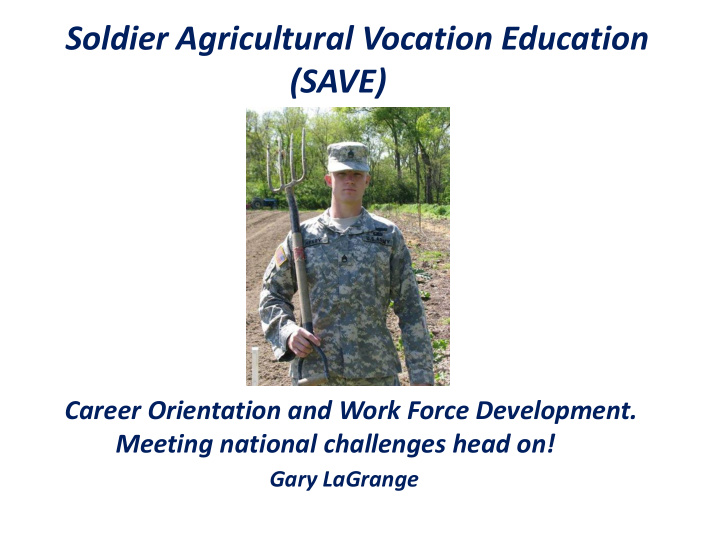



Soldier Agricultural Vocation Education (SAVE) Career Orientation and Work Force Development. Meeting national challenges head on! Gary LaGrange
Bridging a Gap… • “1,500,000 veterans + transitioning soldiers in need of a vocation.” Veterans Administration • “45% desire farming as an occupation.” Department of Labor • “Need 1,000,000 farmers.” • “63% of farms last generation.” • “Avg age near 60. 40% over 65.” • Veteran farmers can fill gap.” Department of Agriculture • “We endorse.” Department of Labor • “We will support.” Department of Defense From soldier to the agricultural workforce Where, how, when can they learn?
Our Vision… • A 150+/- acre training farm. Vets and Active. • Row crops, livestock, orchards, gardens, apiaries, commercial kitchen, allied skills. • Facilities and equipment. • Robust programs of instruction. Apprentice, Journeyman level; then… • Farmer mentors or KSU studies. • A clinic; accommodate disabled. Healing, Therapy, Purpose. • Opens in 3 years; near Fort Riley. • Research. Treatment outcome; Cognitive Processing Therapy, Interpersonal Therapy, Cognitive Behavioral Therapy, etc. A Model for all Land Grant Universities and Military installations .
Classrooms, Admin, Clinic, Residences. Lodging, Chapel Orchards, Gardens, Apiaries Crops Barns, Sheds, Shops Livestock Designed by KSU College of Architecture and College of Agriculture.
Walking the site with KSU graduate students.
Our Partners… • Soldiers and Veterans • The Department of Agriculture • The Department of Veterans Affairs • Fort Riley • Kansas State University • Farmer Veterans Coalition (Kansas Chapter in the works) • Elected Officials • Farm Agencies, Union, Centers • Farmers
Beekeeping; a SAVE Pilot • Shortage of qualified beekeepers in the US • Began training soldiers February 2014 • 38 soldiers; PTSD, TBI; 8 apprentices • Full range sessions: Classroom, Hive, Commercial Kitchen • Colony locations surround Fort Riley • University of Montana Beekeeping Course for now SAVE Master Beekeeping Course to be developed Soldiers helped produce 5240 pounds
Until the Farm is operational… An interim approach; Early Career Orientation • 17 farms of varied types. • 12 farm service organizations. • On site learning sessions. • Over a 90 day period. • Soldiers developed draft plan. Ag Day 18 March. • Farm visits began 3 April. Next iteration this fall. • Business Plan training. Thanks to KSU, Farmer’s Union, Farm Bureau, FVC, KRC, Farmers, Agri-businesses, USDA, Farm Credit, we are underway!
KSU Student Horticultural Gardens And “Homegrown By Heroes” Garden
Soldiers preparing the “Homegrown By Heroes” Garden.
How can you help? • Endorse, collaborate, inform • Refine Business Plan • Design model farm • Advise, assist with POIs, instruction • Network, open doors • Board members: 501C3 Make this farm a reality!
“Under the terms of the International Relief and Developments USAID Program, $300 million had to be spent in one year in Helmand Province alone.” It was largely used to pay farmers and day laborers to clear irrigation ditches which ultimately enabled them to more efficiently grow poppies and produce Opium at record levels. “Program funds ultimately reached $4.1 billion for the fiscal year beginning in October 2009, most of it for USAID, which was eager to spend every penny…In mid 2010, they reached a ‘burn rate’ of $340 million per month.” Governor Tooryalai Wesa, who holds a doctorate in agricultural economics, said, ‘you are killing our culture here’.” Little America, The War Within the War. Rajiv Chandrasekaran, 2012, Vintage Books. An analysis of our strategy and programs in Afghanistan. “There is much more. If we can fund such programs, certainly we can fund something of great value to assist our soldiers and veterans while simultaneously addressing a broad national agricultural need.” Provided by a SAVE active army participant.
Both Democrats and Republicans .They Say, "We're broke". And can't help our own Veterans, Seniors, Orphans, Etc.,????? But, over the last several years, They have provided direct cash aid to..... Hamas - $351 M, Libya $1.45 Billion, Egypt - $397 M, Mexico - $622 M, Russia - $380 M, Haiti - $1.4 Billion, Jordan - $463 M, Kenya - $816 M, Sudan - $870 M, Nigeria - $456 M, Uganda - $451 M, Congo - $359 M, Ethiopia - $981 M, Pakistan - $2 Billion, South Africa - $566 M, Senegal - $698 M, Mozambique - $404 M, Zambia - $331 M, Kazakhstan - $304 M, Iraq - $1.08 Billion, Tanzania - $554 M, A total of $14,933,000,000 “We are the greatest nation on the face of the earth and we therefore have an inordinate responsibility to do what we can to maintain order. Alternatively, we have a responsibility to those who enabled us to remain the greatest nation, our soldiers and veterans. Surely we can build up a school to enable a share of them to transition into agriculture, farming, a most honorable endeavor, in return for all they have done for us. A training farm to enable them to make this transition can be developed for a small fraction of what we give others around the world. They deserve such an opportunity and in the process of giving them this opportunity, we solve some of our perplexing national problems. Veterans and farming; a compelling solution.” LTC, US Army, during a SAVE training session.
Recommend
More recommend